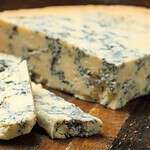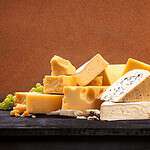Did you know that cheese has been around for over 8,000 years? Or that there are over 2,000 types of cheeses recognized worldwide?
Have you ever bitten into a slice of cheese and wondered just how much there is to know about this tasty treat?
Cheese is one of the world’s most beloved food staples, enjoyed in cuisines around the globe. It often finds itself as an integral part of a dish, bringing flavor and texture to meals. But there are some truly surprising facts about cheese that you may not have heard. From its ancient history to its many uses, get ready to be amazed by some of the unexpected facts about cheese!
History and Origin of Cheese
Cheese has a long and storied history, dating all the way back to the Neolithic era. The earliest evidence of cheese-making dates back to around 6,000 BC, when sheep’s and goat’s milk were first being used to make cheese. While the cheese was likely being made in other parts of the world around the same time, archaeological evidence suggests that the earliest known cheese makers were located in what is now known as the Middle East.
Rennet Discovery
The first cheeses were likely soft and crumbly, made from sour milk. As time went on, cheese makers began experimenting with ways to make it more shelf-stable and tasty. Around 4,000 BC, cheesemakers in the Middle East discovered a way to make cheese with rennet, a substance derived from the stomach of a calf. This resulted in the creation of hard, aged cheeses.
Cheesemaking Development
As cheesemaking spread throughout Europe, cheesemakers experimented with various techniques and ingredients. This led to the development of the many different varieties of cheese that are popular today. Cheesemakers also experimented with different aging techniques to create different flavors and textures.
Cheese became an important part of the diets of many cultures throughout the world. In Europe, cheese was a valuable commodity, and some types of cheese were even used as currency. In the United States, cheese was first introduced by immigrants from Europe in the early 1800s.
Present Cheese
Today, cheesemaking is an important industry in many parts of the world. Many countries have their own unique cheeses, and there are more than 2,000 varieties of cheese in the world. Cheese is used in various dishes, from salads to pizzas, and it is an important part of many cultures’ cuisines.
Interesting Cheese Facts
From its incredible taste to its interesting history, here are some fascinating facts about cheese that you may not have known!
- It’s believed that cheese was first created accidentally when someone stored milk in an animal stomach, and the rennet in the stomach separated the curds and whey.
- The oldest cheese that’s been discovered dates back over 3000 years. This was discovered in Egypt and is believed to be a sheep’s milk cheese.
- The most expensive cheese in the world is called pule and it’s made from Balkan donkey milk. A single pound of this cheese can cost up to $600!
- The record for the largest cheese block ever made is held by a cheese maker in Italy who produced a block that weighed over 1319.5 pounds.
- Cheese can be aged for months or even years to develop its flavor.
- There are over 2,000 types of cheese in the world.
- Cheese is made from many different types of milk. While cow’s milk is the most commonly used for cheese, other types of milk can also be used, including goat’s, sheep’s, and even buffalo’s.
- There are thousands of different types of cheese, ranging from soft, mild varieties to hard, aged cheeses. Some of the most popular cheeses include cheddar, brie, gouda, and parmesan.
- Eating cheese regularly can provide your body with important nutrients like calcium, protein, and vitamin B12. Cheese is also high in healthy fats, which can help protect your heart and reduce your risk of certain diseases.
- The average American consumes around 40 pounds of cheese each year.
- In Europe, the most popular types of cheese are cheddar and gouda.
- The United States is the largest cheese-producing country in the world.
- Parmesan cheese has also been used as a form of currency in Italy.

Unusual Uses for Cheese
Did you know that there are some unusual uses for cheese that you may not have considered?
From adding a layer of flavor to baked goods to preserving produce, cheese is more than just a tasty snack. Here are some of the more unusual uses for cheese that you may want to try in your kitchen.
Cheese in Cocktails
Cheese can be surprisingly versatile when it comes to creating unique drinks. Try adding grated cheese to your favorite cocktails for a new twist.
Cheese as a Binder
Cheese can be used as a binder in all sorts of recipes, from sauces to cheesecakes. Grated cheese can be mixed with other ingredients to form a paste that helps to hold things together. This is especially useful in dishes like pizza, where a cheese-based binder is necessary to hold the toppings in place.
Cheese in Candles
Cheese can also be used to make candles. Just melt some cheese and pour it into a candle mold. Let it cool and you’ll have a unique and fragrant candle.
Cheese as a Glaze
Cheese doesn’t just taste great – it can also be used to give food a glossy sheen. Grated cheese can be mixed with a little olive oil and brushed onto meats before baking. This adds a nice golden color and extra flavor to the dish.
Cheese to Make Hot Chocolate
This one might sound strange but it’s true. Grated cheese can be added to hot chocolate for a delicious and creamy treat.
Cheese for Fondue
Fondue is a Swiss melted dish that’s always served with cheese. But did you know that you can also use cheese as the base for the fondue itself? Grated cheese can be mixed with cream and wine, and then melted together to form a deliciously cheesy dip.
Cheese as a Preservative
Cheese can also be used as a preservative. Certain types of cheese, such as cheddar, can be grated and added to vegetables to help slow down the rate of spoilage. This is especially useful for vegetables that are picked fresh and stored for a long time.
Cheese as a Deodorizer
If you’ve ever had a smelly fridge, you know how unpleasant it can be. Cheese can help with that problem! Just place a slice of cheese in the back of the fridge and it will absorb odors and leave your fridge smelling fresh.
Cheese as a Topping
Cheese isn’t just for pizza! It can also be used as a topping on all kinds of dishes, from salads to burgers. Grated cheese can add a little extra flavor and texture to any meal.
These are just a few of the unusual uses for cheese that you can try. Cheese is a versatile and delicious ingredient that can be used in a variety of ways. So don’t be afraid to get creative and explore the different ways you can use cheese in your cooking and baking.
Cheese Production by Country
In terms of global production, the United States holds the top spot with an estimated 5.6 million tons produced annually. This is followed by Germany which produces around 2.7 million tons per year. Other European countries such as France and Italy also produce many types of cheese that are popular within their own borders as well as exported across the globe.
Top 10 Cheese-Producing Countries
| No. | Country | Production (Million Tons) |
| 1 | United States of America | 5.6 |
| 2 | Germany | 2.7 |
| 3 | France | 1.9 |
| 4 | Italy | 1.25 |
| 5 | The Netherlands | 0.77 |
| 6 | Poland | 0.74 |
| 7 | Russian Federation | 0.66 |
| 8 | Egypt | 0.62 |
| 9 | Czech Republic | 0.57 |
| 10 | Argentina | 0.56 |
Cheese Consumption Around The World
In 2021, the European Union consumed nearly 9.1 million metric tons of cheese, according to Statista. That’s an impressive figure, but it doesn’t even begin to tell the whole story. The way that cheese is consumed varies greatly from region to region.
Europe
In Europe, cheese is an integral part of the diet, with many countries having a long and storied tradition of cheese production and consumption. In France alone, the average person consumes nearly 57.9 pounds of cheese each year. In other countries in Europe, such as Italy, per capita cheese consumption is 48 pounds, and the Netherlands consumes 42.7 pounds of cheese per capita per year.
North America
In North America, cheese consumption is not as high as it is in Europe. The average American consumes under 40 pounds of cheese each year. However, cheese is still an important part of many diets, especially in the form of pizza, macaroni, and grilled cheese sandwiches.
Asia
In Asia, cheese isn’t as popular as it is in the West. However, it is consumed in certain countries, such as Japan and South Korea. In Japan, cheese is mostly eaten in the form of natto, a fermented soybean dish. In South Korea, cheese is mostly consumed in the form of a traditional cheese soup called jeonju jang.
Latin America
In Latin America, cheese is mostly consumed in the form of queso fresco, a fresh, mild-flavored cheese that is often used in Mexican cuisine. In Brazil, cheese is mostly eaten in the form of queijo fresco, a type of creamy white cheese that is often served with rice.
Cheese consumption around the world is an interesting and diverse topic. From Europe to Asia, Latin America to North America, cheese is an important part of many diets. While the amount of cheese consumed in each region varies, it’s clear that cheese is a beloved food all over the globe.

Some Fun Facts about Cheese
Cheese is so beloved that people have dedicated entire festivals to the delicious treat. Whether you’re a cheese connoisseur or just love a good snack, here are some fun facts about cheese you may not have known.
- Cheese has been around since at least 6,000 BC, making it one of the oldest known types of food.
- The largest cheese sculpture in the world was created in Louisiana, USA, by Erik Acquistapace and weighed 3,121 lbs.
- The first cheese factory in the United States was established in 1851 in New York.
- The largest cheese platter in the world was created by Dairy Farmers of Wisconsin (USA) in 2018 and weighed 4,437 lbs.
- The most widely produced cheese in the world is cheddar, which originated in England.
Cheesemaking Process (Ancient & Todays)
Cheesemaking is an ancient craft that dates back thousands of years. Since then, the process of cheesemaking has been refined and perfected, resulting in the wide variety of cheeses that we enjoy today.
The ancient cheesemaking process involved several steps. The first step was to acquire raw milk from cows, goats or sheep. This milk was then heated to a certain temperature, usually around 90°F. This process, called coagulation, caused the milk proteins to form a solid curd. The curd was then cut into smaller pieces and stirred until it reached the desired consistency.
The curds were then placed in a cylindrical mold and pressed with heavy weights. This process, called pressing, forced the moisture out of the curd and created a solid cheese block. The cheese block was then aged in a cool, dark room. During this aging period, bacteria and enzymes added flavor and texture to the cheese.
Finally, cheesemakers would add salt or other ingredients to the cheese. This step, called finishing, gave the cheese its character and taste.
Today, many of the steps of the ancient cheesemaking process remain the same. However, modern technology has made the process faster and easier. Machines now control the temperature of the milk, the pressing process and the aging period. Cheesemakers can also create different flavors and textures by adding different ingredients at the finishing stage.
The ancient art of cheesemaking continues to be enjoyed by cheese-lovers around the world. Through the millennia, cheesemakers have perfected their craft and created delicious cheeses that can be enjoyed by everyone.
Popular Variety of Cheese Types
The variety of cheeses available is nearly endless. From creamy, soft cheeses to hard, crumbly cheeses, each type offers a unique flavor and texture.
Whether you’re trying to create a delicious meal or just snack on something, cheese can definitely be a part of it. But with all the different types of cheese out there, it can be hard to know which one to choose. That’s why I’ve put together a guide of some of the most popular types of cheese.
Cheddar Cheese
One of the most popular types of cheese is Cheddar. Cheddar is a hard, yellow cheese that is commonly used in sandwiches and burgers. It’s also a great grilling cheese, and it melts very nicely. Cheddar is available in a variety of flavors, including mild, medium, sharp, and extra sharp.
Parmesan Cheese
Another best-known type of cheese is Parmesan. Parmesan is a hard, crumbly cheese that is a staple in Italian cooking. It’s used to top pizzas, salads, and sauces. Parmesan is also available in a variety of flavors, including mild, aged, and extra aged.
Mozzarella Cheese
Mozzarella is a milky, stretchy cheese that is most commonly used on pizza. It melts quickly and easily, making it a perfect option for grilling or baking. Mozzarella is also used in salads and sandwiches, and it’s available in a variety of flavors, including mild, medium, and smoked.
Brie Cheese
Another type of cheese that is popular around the world is Brie. Brie is a soft, creamy cheese that is perfect for spreading on crackers or bread. It is also a great melting cheese, and it’s often used in quiches, tarts, and other baked goods. Brie is available in a variety of flavors, including mild, medium, and aged.
Feta Cheese
Finally, a cheese that is becoming increasingly popular is Feta. Feta is a crumbly, salty cheese that is commonly used in salads, pastas, and other dishes. It’s also a great topping for pizzas and sandwiches, and it’s available in a variety of flavors, including mild, medium, and aged.
These are just a few of the popular types of cheese. Whether you’re looking for something to snack on or for a recipe, there’s cheese for you. So don’t be afraid to experiment and find the perfect cheese for your next meal.
Nutritional Benefits of Cheese
Cheese is packed with a host of nutritional benefits, making it a great addition to any healthy diet.
Calcium and Protein
Cheese is an excellent source of calcium and protein, both of which are essential for a healthy diet. One ounce of cheese contains about 200 milligrams of calcium, which is about 20 percent of the recommended daily intake for adults. Cheese is also a good source of protein, with one ounce containing about seven grams of protein. Protein helps build and maintain muscle mass, which is important for overall health.
Vitamins and Minerals
In addition to calcium and protein, cheese is also high in other essential vitamins and minerals. It is a great source of vitamins A, B2, B12, D, and K. It also contains a range of minerals including phosphorus, zinc, and magnesium. These vitamins and minerals are important for maintaining healthy bones, teeth, and muscles.
Probiotics
Cheese is also a great source of probiotics, which are beneficial bacteria that help our bodies to digest food and absorb nutrients. Probiotics can help to reduce inflammation, boost the immune system, and improve digestion.
Cheese is also high in fat, but it is mostly saturated fat. While it is recommended to limit saturated fat in the diet, cheese can still be enjoyed as part of a healthy diet. The fat in cheese helps with the absorption of other nutrients, including calcium.
In conclusion, cheese is an incredibly nutritious food that can be enjoyed in moderation. It can provide a good source of protein and calcium, as well as many additional vitamins and minerals. Plus, it’s a delicious way to get a healthy dose of healthy fats. So, go ahead and indulge in some cheese – your body will thank you!

Frequently Asked Questions
Why is cheese called cheese?
The term ‘cheese’ is derived from the Latin word caseus, which is thought to have originated from a Proto-Indo-European root, kwat. The word caseus has been used to refer to fermented milk products since antiquity. This term was adopted by various Germanic languages such as Old English, where it eventually evolved into the modern English version of “cheese”.
Can you freeze cheese?
Yes, you can freeze the cheese. But the ability to freeze certain types of cheese is contingent upon the particular composition of the dairy product. Certain cheeses, such as Cheddar and Swiss, are better suited for freezing due to their higher fat content, which allows them to withstand extreme temperature changes without developing a grainy texture. Conversely, cheeses with lower fat content, such as Brie, tend to become crumbly or mushy when frozen.
How long does cheese last in the fridge after opening?
The shelf life of cheese after being opened and stored in the refrigerator is highly dependent upon the type of cheese and storage conditions. Generally, soft cheeses have a shorter shelf life of 7 days due to their higher moisture content and increased likelihood to spoil, while hard cheeses can last 3-4 weeks.
Furthermore, optimal storage conditions such as storing cheese in an airtight container, or wrapping it tightly in plastic wrap to reduce contact with air will extend the shelf life of opened cheese significantly. The optimal temperature range for storing opened cheeses is approximately 33-40°F
Final Thoughts on Cheese Facts
I’ve highlighted just a few of the interesting facts about cheese. I hope these facts have piqued your interest in this beloved food. With its long history and versatility, cheese is an important part of many cultures and diets. Whether you’re an experienced cheese enthusiast or just starting to explore the world of cheese, there’s always something new to learn.
So the next time you bite into a cheesy slice of pizza, think about all the fascinating facts that come along with it.
Thanks for reading!






